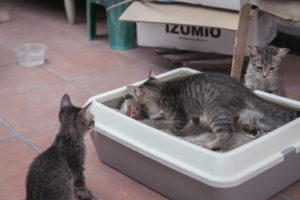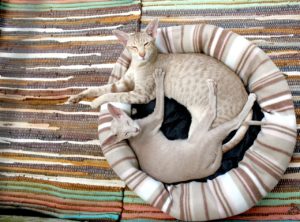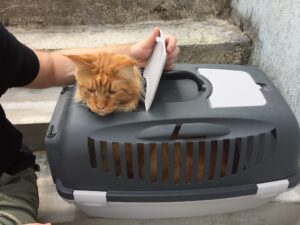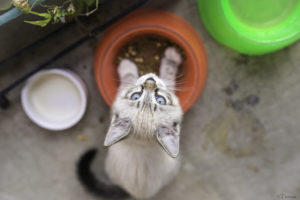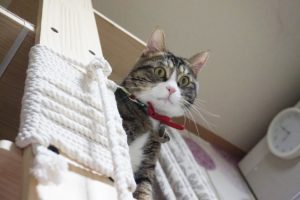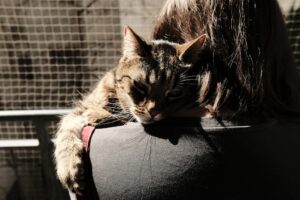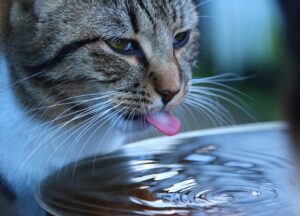As every cat owner will be aware, cat hair seems to get stuck everywhere! There are many tools available to help remove pet hair including vacuum cleaners, brushes, sponges and lint rollers.
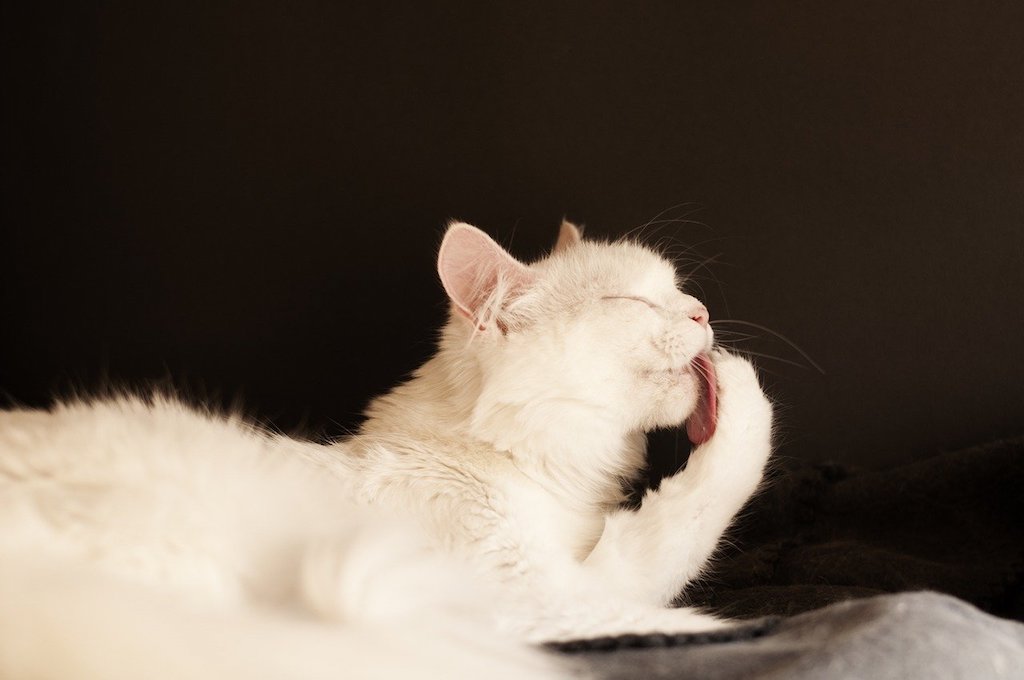
Why do cats shed so much hair?
It can be alarming or annoying to see your beloved pet leaving piles of hair all over your clothes and furniture. However, shedding hair is a completely normal thing for cats to do. We just have to accept that this is part of the life of a cat-owner and figure out the best way to deal with it.
Every day, old hair falls out and is replaced by healthy new hair. Some cats shed more hair at certain times of year, particularly when warm spring weather arrives.
Cats will groom themselves as part of the shedding process. Your cat should self-groom for several hours each day but during this process they may ingest a lot of fur. This can lead to hairballs – a collection of hair which accumulates in the stomach. These normally pass through the gastrointestinal tract or are occasionally vomited up. Hairballs are a normal occurrence but can occasionally cause problems such as regular vomiting, lethargy and reduced appetite.
Shedding hair is rarely a cause for concern, but cat owners should watch out for abnormal shedding patterns. Some medical conditions can lead to poor hair regrowth, such as allergies, skin disease or stress. If your cat is not self-grooming adequately then the hair may become matted and uncomfortable with skin sores. If you are concerned that your cat is shedding his coat abnormally it is important to seek veterinary advice.
Why does cat hair stick to clothes and furniture?
As every cat owner will be aware, cat hair seems to get stuck everywhere! There are many tools available to help remove pet hair including vacuum cleaners, brushes, sponges and lint rollers.
Top tips for dealing with cat hair on clothes and furniture
-
Groom your cat to reduce hair shedding
Grooming your cat goes right to the source of the problem, removing the dead hair before your cat has chance to shed it on furniture or clothes. Spending a few minutes each day brushing your cat will help to loosen and remove dead hairs. Grooming also stimulates the circulation and helps keep your cat’s coat healthy. Grooming should be an enjoyable experience for both you and your cat, helping to create a close emotional bond.
There are many grooming brushes available to help remove hair from your cat.
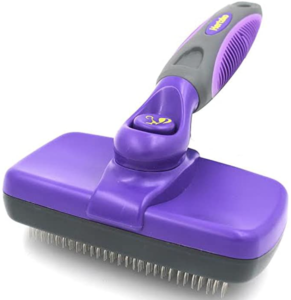
View on Amazon
For short haired cats use a rubber mitt to stroke your cat, these are very effective at loosening dead hair.
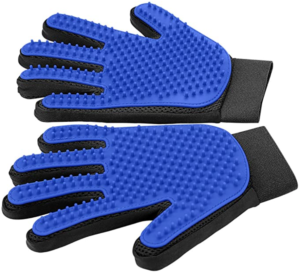
A comb such as the FURminator is more effective for longer haired cats.
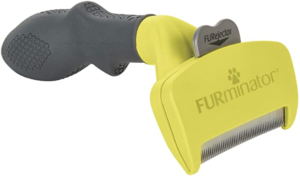
Use any grooming tool gently at first until your cat gets used to it. There are also fur removal and dematting combs available, but it would be advisable to speak to a grooming expert before using these on your cat.
-
Use sponges and rubber gloves to remove cat hair from upholstery
This is one of the best kept secrets when it comes to removing cat hair from furniture – a dampened sponge or rubber glove! Simply moisten the sponge or rubber gloves and wipe over your upholstery. The hair will stick to the sponge or gloves, and can then be rinsed off under the tap or in a bowl of water.
One of the advantages to this technique are that sponges and rubber gloves are relatively cheap to buy. Once purchased they can be used again and again. Make sure that you only use this technique on fabrics which will not be damaged by water.
-
Use pumice stones to remove cat hair from carpets
Using a pumice stone is a great way to remove cat hair from carpets. Lightly run the pumice stone over the surface of the carpet and the cat hair will stick to it or gather in a ball. The hair can then easily be picked up or vacuumed, leaving your carpet clean and hair-free.
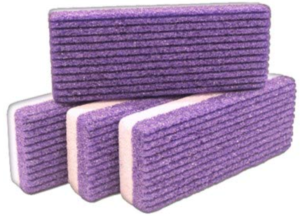
The advantage to pumice stones is that they are inexpensive and reusable, in fact you may already own one! However, it could be time consuming to use a pumice stone on your entire carpet on a regular basis. It may only be practical to use this technique on smaller problem areas of the carpet.
-
Wash clothes effectively to remove cat hair
Have you ever washed your clothes and been frustrated that they’re still covered in cat hair? Try popping dry clothes into the laundry dryer on a low heat cycle for ten minutes before washing them. This will loosen the cat hairs and allow them to be collected in your dryers lint trap. Popping a damp microfiber cloth into the dryer with your clothes makes this technique even more effective. The cat hair will stick to the microfiber cloth instead of your clothes.
When washing fabrics which are particularly covered in cat hair, make sure that you clean the washing machine afterwards. Cat hair will collect on the inside of the machine, ready to stick to the next load of laundry. Wipe inside the drum and round the seals to remove hair and dirt. Running a short empty cycle will rinse away any left over hairs from the inside of your machine.
-
Use lint rollers and clothes brushes for quick removal of cat hair
These are great for instantly removing cat hair from your clothes and furniture when you are short of time. There are a wide variety of clothes brushes and lint rollers available to buy. These quickly and effectively remove cat hair when rolled over fabrics.
The type of roller most people will be familiar with is one with disposable sticky sheets. These are very effective at removing cat hair from clothes or furniture. The roller is simply rolled over any cat hairs which stick to the disposable sheet. After use the sticky sheet can be removed and discarded. If you don’t have a roller available, then try using some sticky tape or packing tape wrapped around your hand to dab away cat hair from clothes and furniture.
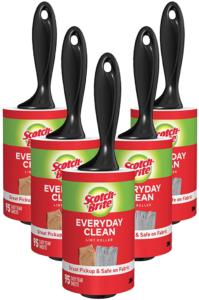
A more sustainable version of the disposable roller is a reusable lint roller reusable lint roller or clothes brush. These work by picking up cat hairs as they are gently brushed over your clothes or furniture. The hair is easily removed from the brush so they can be reused again and again. There are many different types of reusable rollers and brushes available now, so you are spoilt for choice!

View on Amazon
-
Vacuum regularly and effectively
Sometimes, no matter how much you wash and brush your clothes and furniture, there are still some stubborn cat hairs remaining. The longer that cat hair lies on your fabrics the deeper it becomes embedded into the fibers, making it harder to remove. Regular vacuuming of your furniture is essential to remove those irritating cat hairs before they become a problem.
Some brands and types of vacuum cleaners are more effective than others at picking up cat hairs. There are even vacuum cleaners specifically designed for households with pets. Removing cat hair is also the perfect time to try out all those nozzles and attachments your vacuum cleaner came with. These can be particularly effective for vacuuming the crevices in your furniture.
When vacuuming carpets it can be frustrating to see that cat hairs are often left behind. Once cat hairs are tangled and embedded into the fibers of the carpet the vacuum cleaner struggles to pick them up. Try brushing your carpet before vacuuming to loosen the hair. There are even rubber bristle brushes available for just this purpose!
It may be necessary to use another technique such as damp rubber gloves to loosen and remove thick layers of cat hair before vacuuming. Once your clothes, furniture and carpets are clean and free from hair then try to vacuum regularly before it builds up again. A small hand-held vacuum cleaner can be great for doing a quick clean of problem areas such as your cat’s favorite super-snuggly cushion.
-
Use floor sweepers on solid foors
Laminate and hard wood floors wouldn’t seem like an obvious place for cat hairs to stick, but they can cause problems for cat owners. Sweeping or vacuuming solid floors can blow cat hair up into the air, causing it to stick to your furniture and clothes. A quick wipe with a microfiber dry mop is a great solution to this problem. The electrostatic action of the mop attracts and collects cat hairs before they stick to your clothes or furniture.
Effective ways to prevent and get rid of cat hair
It is clear to see that there is no ‘one size fits all’ solution to getting rid of cat hair from your clothes and furniture, but we hope we’ve given you some inspiration for how to deal with the problem of cat hair. The most useful step you can take is to remove the hair before it is shed by giving your cat some regular grooming sessions. What better excuse do you need to treat your feline favorite to some daily pampering than a hair-free home and wardrobe!

